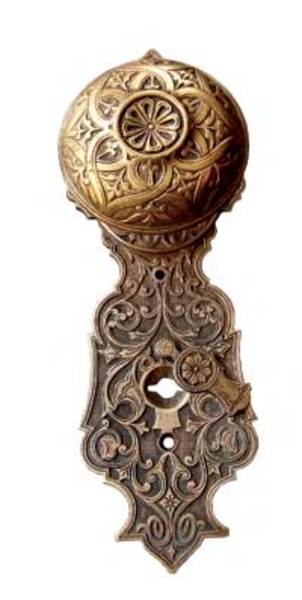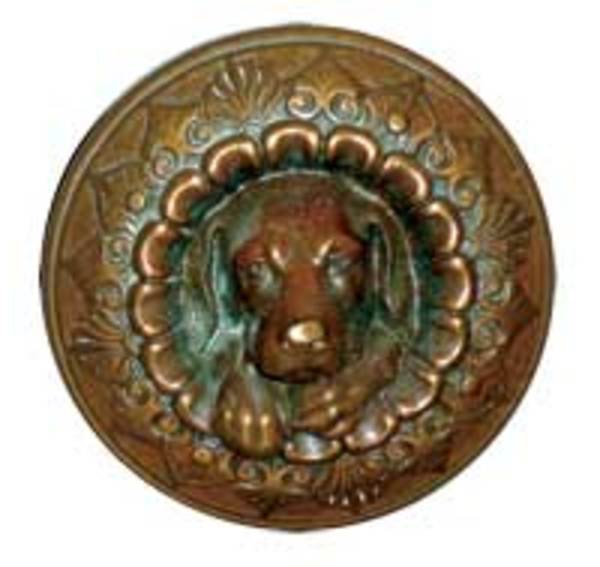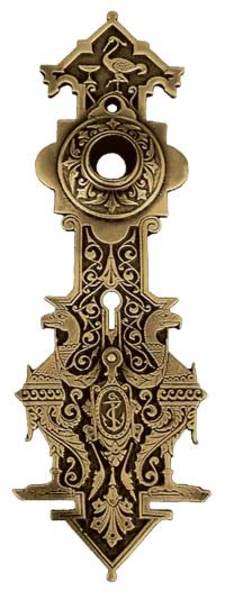This knob-and-escutcheon set by P. & F. Corbin appeared in the company’s 1874-75 catalog, and also was produced in extremely rare cast enamel. Allen Joslyn
Like most decorative objects appearing during the Victorian era, door hardware was highly ornamental—but it didn’t start out that way. Queen Victoria’s reign began in 1837, but throughout the 1840s and ’50s, American door hardware remained undecorated—simple but elegant. Locks were likely to be cast-iron rim locks (screwed to one side of the door), or for the well-to-do, brass rim locks without decoration (although a handful of decorated iron rim locks were patented as early as 1858). Knobs were bronze, silvered, silvered glass, or, in the case of interior knobs, highly polished wood.
On the front door, the keyhole sat beside the knob with a separate keyhole cover, in contrast to later mortise locks, where the keyhole appeared below the knob with a single exterior escutcheon. Most houses used pottery or porcelain knobs. Pressed glass knobs gained popularity during this period and remained in fashion throughout the 19th century.
Decorative Door Hardware
After the Civil War, door hardware changed radically. Some early design patents for decorated hardware were for coffin handles, but it didn’t take long for decoration to spread to door hardware. By 1869, design patents for hinges, escutcheons, and an outside door latch were granted, as well as the first design patent for a decorated doorknob made of shellac and silica.
R&E’s original doggie knob, which debuted in 1870, is now a highly coveted piece among collectors. Allen Joslyn
The fervor for decorative door hardware was soon heightened by a new casting technique that introduced molten bronze into a mold under pressure, producing castings of exceptional detail. This process was spearheaded by Russell & Erwin Manufacturing Company of New Britain, Connecticut (R&E), which turned out a host of popular designs, the most famous being the “doggie” knob. Other whimsical R&E creations included an escutcheon depicting a flamingo drinking champagne and a large lion’s-head knob. Once the R&E designs debuted, a flood of imitations followed.
In the wake of Japan’s displays at the 1876 Centennial in Philadelphia, America fell in love with Japanese designs and their asymmetrical, geometric depictions of exotic birds, butterflies, sunflowers, bats, and owls. R&E again led the trend, introducing a line of Japonesque hardware in 1879 with motifs such as geishas, cranes, and bluebirds. Other manufacturers followed suit—Sargent’s “Ekado” pattern debuted in 1885. Eventually, the Japonesque hardware trend merged into the overall Aesthetic Movement, which applied naturalistic Asian, Middle Eastern, and Gothic themes to a variety of decorative objects. In the late 19th century, manufacturers began to branch out by applying decorative elements from previous eras, such as the Italian Renaissance, to their hardware.
The turn of the century marked the beginning of the end for decorative hardware, although some ornamentation could still be found on the stamped steel escutcheons and knobs in the Sears & Roebuck catalogue. The clean lines of Art Deco and Arts & Crafts hardware soon ushered in a new era of simple forms and hand-finished surfaces. By the 1920s, interest in decorative hardware had largely disappeared.
Learn how to clean antique hardware.
Authentic reproductions, such as this R&E Stork doorplate from Vintage Hardware, are available from several manufacturers.
Hardware Hunting
Once you know what type of hardware you need, how do you actually find it? If you want to outfit your entire house with the same pattern of original antique hardware, collecting it can take years. Some of this hardware is anxiously sought by collectors and doesn’t appear very often—for example, in the last year, R&E doggie knobs appeared on eBay only a few times. Then there’s the fact that rare hardware isn’t cheap, although prices have dropped in recent years. Even apart from rarer items, assembling a set of eight knobs and escutcheons of a relatively popular set of door hardware takes time.
One alternative is to look for reproductions, either as a whole set or to complete an existing antique one. Many of these are of very high quality, and some are difficult to distinguish from the originals. Be forewarned, though, that sometimes reproductions can cost as much as—or even more than—originals.
Another option is to forgo uniformity in your house’s hardware: Buy and install whatever antique hardware appeals to you. If you’d still prefer some degree of consistency, you can match hardware within a room—but it’s likely that your guests will be so enchanted by seeing something other than a plain knob that they won’t even notice the differences. And if anyone does comment on your eclecticism, simply smile and say, “Don’t you think variety is more interesting?”
Allen Joslyn is a director of the Antique Doorknob Collectors of America, and the editor of its newsletter, The Doorknob Collector.
View all hardware in the Products & Services Directory.







